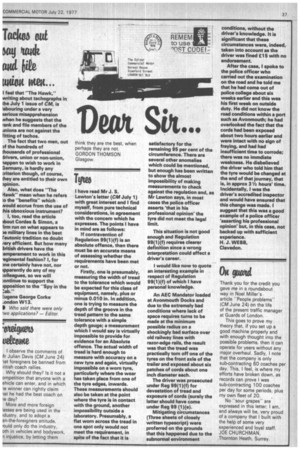Too
Page 39

If you've noticed an error in this article please click here to report it so we can fix it.
I have read Mr J. S.
Lawton's letter (CM July 1) with great interest and I find myself, from pure technical considerations, in agreement with the concern which he expresses. The points I have in mind are as follows: If contravention of Regulation 99(1)(f) is an absolute offence, then there must be an accurate means of assessing whether the requirements have been met or not.
Firstly, one is presumably, measuring the width of tread to the tolerance which would be expected for this class of equipment, namely, plus or minus 0.010 in. In addition, one is trying to measure the depth of the groove in the tread pattern to the same tolerance with a simple depth gauge; a measurement which I would say is virtually impossible to provide for evidence for an Absolute offence. The actual width of tread is hard enough to measure with accuracy on a new tyre and again, virtually impossible on a worn tyre, particularly where the wear has taken place from one of the tyre edges, inwards. These measurements should also be taken at the point where the tyre is in contact with the ground, another impossibility outside a laboratory. Presumably, a flat worn across the tread in one spot only would not meet the requirement, in spite of the fact that it is satisfactory for the remaining 95 per cent of the circumference. There are several other anomalies which could be mentioned, but enough has been written to show the almost impossibility of making measurements to check against the regulation and, as Mr Lawton says, in most cases the police officer asserts 'that in his professional opinion' the tyre did not meet the legal limit.
This situation is not good enough and Regulation 99(1)(f) requires clearer definition since a wrong interpretation could affect a driver's career.
I would like now to quote an interesting example in respect of Regulation 99(1)(f) of which I have personal knowledge.
An AEC Mandator loaded at Avonmouth Docks and due to the extremely bad conditions where lack of space requires turns to be made at the minimum possible radius on a shockingly bad surface over old railway lines with razor-edge rails, the result was that the tread was practically torn off one of the tyres on the front axle of the trailer and exposed about six patches of cords about one inch diameter each.
The driver was prosecuted under Reg 99(1)(f) for devastation of tread and exposure of cords (surely the latter should have come under Reg 99 (1)(e).
Mitigating circumstances (Three sheets of closely written typescript) were prof erred on the grounds that this happened due to the subnormal environment conditions, without the driver's knowledge. It is significant that these circumstances were, indeed, taken into account as the driver was fined £15 with no endorsement.
After the case, I spoke to the police officer who carried out the examination on the road and he told me that he had come out of police college about six weeks earlier and this was his first week on outside duty. He did not know the road conditions within a port such as Avonmouth; he had overlooked the fact that the cords had been exposed about two hours earlier and were intact with no sign of fraying, and had had insufficient time to corrode; there was no immdiate weakness. He disbelieved the driver who told him that the tyre would be changed at the end of that journey, that is, in approx 3½ hours' time. Incidentally, I was the driver's accredited inspector and would have ensured that this change was made. I suggest that this was a good example of a police officer 'asserting his professional opinion' but, in this case, not backed up with sufficient experience.
H. J. WEBB, Clevedon.




























































































